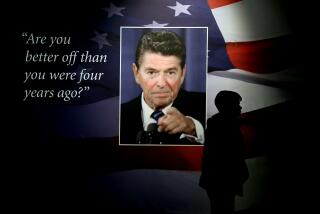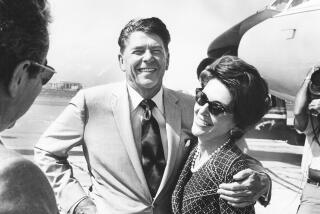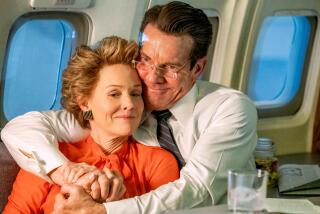Reagan Recants ‘Evil Empire’ Description
- Share via
MOSCOW — President Reagan, standing within the fortress walls of the Kremlin with a smiling Mikhail S. Gorbachev at his side, said Tuesday that he no longer sees the Soviet Union as “the evil empire.”
“You are talking about another time, another era,” he said in an exchange with a handful of reporters clustered around a 39-ton cannon dating from 1586 that stands in a plaza in the center of the Kremlin.
Reagan was disavowing one of his most famous indictments of the Communist state--a description of the Soviet Union that seemed to symbolize his ultraconservative, anti-Communist views when he used it seven years ago in one of his first presidential speeches.
The change seems to reflect an evolution in his views on the Soviet Union. It has been noticeable in his statements and policy decisions for some time but has emerged with dramatic vividness here in the President’s face-to-face encounter with Moscow.
The question about the “evil empire” statement came near the end of a walking tour of the Kremlin grounds and fabled Red Square, with all its memories of celebrations of the Bolshevik Revolution and May Day parades of Soviet military power.
Explains His Position
Asked if he still considers Moscow to be the seat of evil, Reagan answered, “No.” Surprised, reporters asked why.
Reagan hesitated, leaned his head to one side and thought a bit. Soviet leader Gorbachev tried to prompt him. “Are you happy with that concept?” he asked in Russian. The President then responded by saying that the phrase belonged to an earlier time.
Reagan recanted even though Gorbachev had told a crowd of Russians that he did not mind Reagan’s criticisms over the years. “We are so critical of our own country that even the President’s criticisms are weak,” the Soviet leader said. “We know what our problems are.”
In some ways, the President’s walk across Red Square was just as symbolic as his rejection of the concept of “the evil empire.” It would have been hard at the outset of his presidency to conceive of Reagan taking in the sights of Red Square and enjoying them. But on Tuesday the President said:
“I have always heard of Red Square. Mr. Gorbachev was kind enough to show it to me. And now I have seen it and set foot on it. It was much more impressive than I had imagined.”
Reagan’s determination to show how his mood had changed in recent years was evident later in the day when he spoke with writers and artists at the House of Writers in Moscow. In a short but warm speech that described his philosophy of acting and how it had helped prepare him for the White House, Reagan described the importance in the theater of avoiding rigid, stereotyped thinking and instead understanding the unique character of each situation and individual.
No Straitjacket
“Pretty soon,” he said, “at least for me, it becomes harder and harder to force any member of humanity into a straitjacket, into some rigid form in which you all expect to fit.
“In acting . . . you become in an intimate way less taken with artificial pomp and circumstance, more attentive to the core of the soul--that part of each of us that God holds in the hollow of his hand and into which he breathes the breath of life.”
Whatever view he may once have had of Soviet leaders and citizens, he could not be accused now of keeping them in a straitjacket. There was little doubt about the President’s warm feelings for many of them now, and this could be seen on his morning walk.
After meeting for more than an hour in the Kremlin, Reagan followed the Soviet leader on a tour of the grounds and Red Square. As the two men walked slowly, Gorbachev, with sweeps of his hand, pointed out the turrets, churches, palaces and other buildings. A cluster of aides and a long line of limousines trailed behind.
Red Square, an enormous plaza alongside the northeast wall of the Kremlin, is known to the outside world as the site of the massive demonstrations of Soviet military power on the annual May 1 celebration of the Bolshevik Revolution. But it has existed for five centuries, and its name has nothing to do with communism.
‘Red’ Means ‘Beautiful’
The plaza has been known as Red Square for three centuries. When the square was first named, the present-day Russian word for “red” meant “beautiful.”
Gorbachev pointed out the sights of the square: St. Basil’s Cathedral with its famous onion domes, the huge GUM department store, the Historical Museum and the Lenin Mausoleum that contains the body of V. I. Lenin, the first Soviet leader.
“We are not going to change anything here,” Gorbachev said as the two leaders stood outside the tomb. “There is no perestroika needed.”
Reagan made no attempt to enter the mausoleum to honor a man who has become a god-like figure in the Communist world, and Gorbachev made no attempt to try to persuade him.
The exchanges of Reagan, Gorbachev and some of the Russians in the square left little time for true sightseeing, but they were consistent with both leaders’ efforts to surround the tough negotiations over arms control with an aura of better feeling.
Need for Dialogue
At one point, Reagan and Gorbachev, talking with some Soviet citizens, turned philosophical about the need for face-to-face dialogue.
“What we have decided to do,” the President said, “is to talk to each other and not about each other, and that’s working just fine.”
Gorbachev used a Russian proverb to make the point: “If arguments are at the boiling point, then truth evaporates. So we should have dialogue.”
During this conversation, Reagan put his arm around Gorbachev and said, “I’m glad we are standing here together like this.”
In talking with one group of Russians, the superpower leaders said they had discussed annual student exchanges. “I have a dream,” the President said, “that if all young people of the world could get to know each other, it would be a better world.”
‘Grandfather Reagan’
At another point, a woman holding a small child told the President, “We want our children to live in peace.” Gorbachev then took the child from the mother’s arms and told the child, “Shake hands with Grandfather Reagan.”
Reagan took the child’s hand in his.
After the walk in Red Square, Gorbachev led Reagan back within the Kremlin walls, directing him to a small group of journalists and camera crews waiting near the huge cannon, which had never been fired. Gorbachev evidently had an announcement for Soviet television.
“We have received several important telegrams to tell the Reagans that newly born boys and girls are being named Ronald and Nancy and Reagana,” the Soviet leader said.
But the foreign journalists were interested in other issues. “Do you still believe you are in the evil empire?” Reagan was asked. “No,” he replied, surely and quickly.
More to Read
Get the L.A. Times Politics newsletter
Deeply reported insights into legislation, politics and policy from Sacramento, Washington and beyond. In your inbox three times per week.
You may occasionally receive promotional content from the Los Angeles Times.










